History
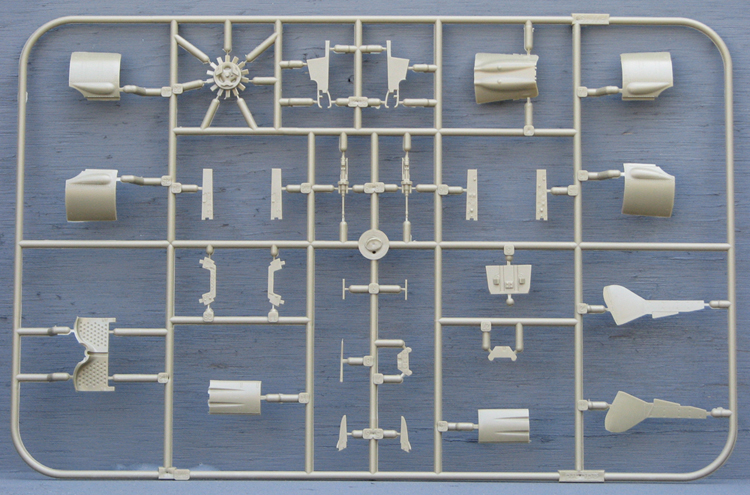 The prototype of the Focke Wulf Fw190 first flew on June 1, 1939, but it did not enter service with the Luftwaffe until June 1941, appearing over northwest France. The two-year gap was due to improvements to the prototype followed by a series of service trials, which revealed several flaws prompting RLM to halt further development. After some 50 additional modifications, the Fw190 entered service, and by September 1941, it fully equipped II/JG 26 on the Western Front. It was a high-performance, heavily armed fighter, and rapidly demonstrated its superiority over the Spitfire Mk V, Britain's best fighter of the period.
The prototype of the Focke Wulf Fw190 first flew on June 1, 1939, but it did not enter service with the Luftwaffe until June 1941, appearing over northwest France. The two-year gap was due to improvements to the prototype followed by a series of service trials, which revealed several flaws prompting RLM to halt further development. After some 50 additional modifications, the Fw190 entered service, and by September 1941, it fully equipped II/JG 26 on the Western Front. It was a high-performance, heavily armed fighter, and rapidly demonstrated its superiority over the Spitfire Mk V, Britain's best fighter of the period.
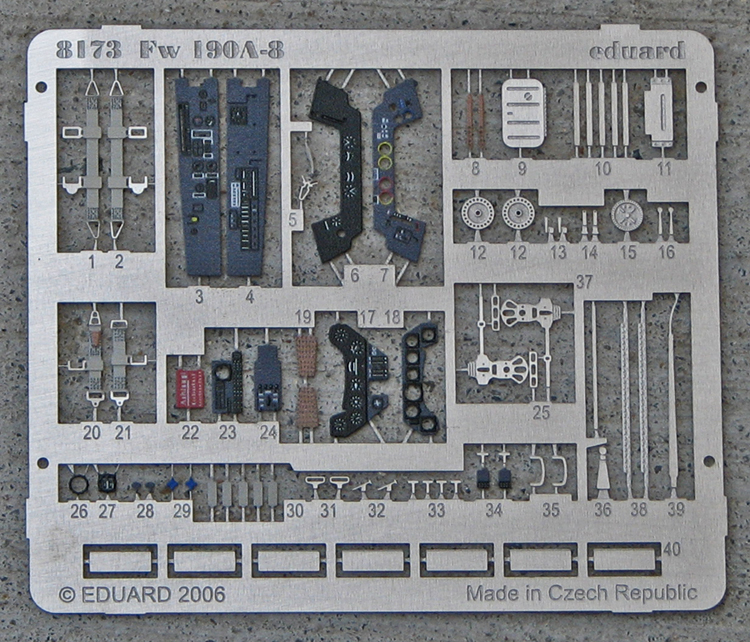 The A series of the Fw190 was powered by various versions of the BMW 801 double radial engine. Although the first production versions of the Fw190 were armed with four 7.92mm machine guns, by the time the A-8 entered service, armament had evolved into two fuselage-mounted 13mm machine guns and four wing-mounted MG151 20mm cannon, one in each wing root and one just outboard of the wheel wells. The A-8 was the most widely produced version of the Fw190 with 1400 units built. The most significant change to the A-8 was the addition of a GM-1 nitrous oxide injection system, providing a temporary power boost to the engine in combat. Some versions of the A-8 were built as the A-8/R2 and A-8/R8, with the heavier Mk 108 cannon in the outer wing and armoured slabs added to the cockpit sides with a modified canopy.
The A series of the Fw190 was powered by various versions of the BMW 801 double radial engine. Although the first production versions of the Fw190 were armed with four 7.92mm machine guns, by the time the A-8 entered service, armament had evolved into two fuselage-mounted 13mm machine guns and four wing-mounted MG151 20mm cannon, one in each wing root and one just outboard of the wheel wells. The A-8 was the most widely produced version of the Fw190 with 1400 units built. The most significant change to the A-8 was the addition of a GM-1 nitrous oxide injection system, providing a temporary power boost to the engine in combat. Some versions of the A-8 were built as the A-8/R2 and A-8/R8, with the heavier Mk 108 cannon in the outer wing and armoured slabs added to the cockpit sides with a modified canopy.
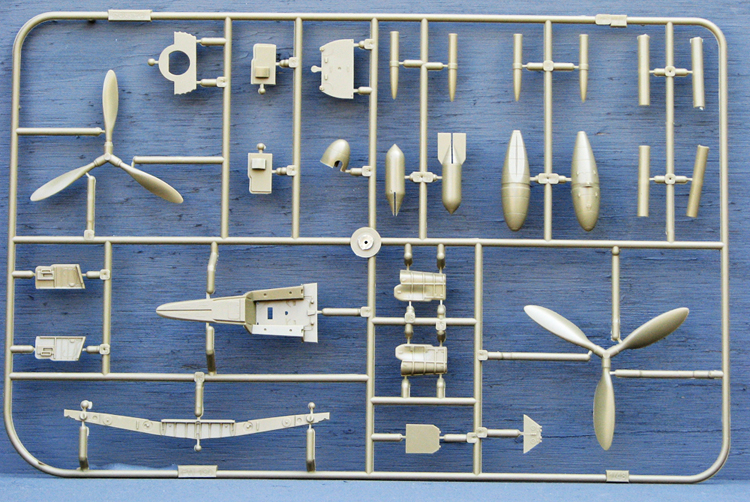 Although a more advanced design, the Fw190 was never employed as widely by the Luftwaffe as the competing Messerschmitt Bf109. Nonetheless, it distinguished itself with deadly effect as an interceptor during the campaign to defend the Reich against Allied bombers. The danger they posed to B-17 and B-24 formations was kept in check to a degree by P-47 Thunderbolts, and necessitated the development of the P-51 Mustang.
Although a more advanced design, the Fw190 was never employed as widely by the Luftwaffe as the competing Messerschmitt Bf109. Nonetheless, it distinguished itself with deadly effect as an interceptor during the campaign to defend the Reich against Allied bombers. The danger they posed to B-17 and B-24 formations was kept in check to a degree by P-47 Thunderbolts, and necessitated the development of the P-51 Mustang.
The Kit
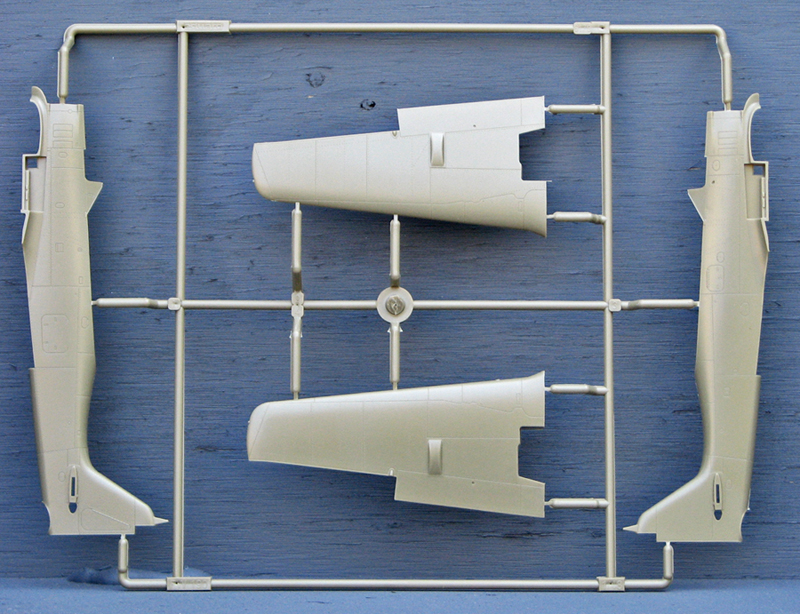 The Fw 190 is molded in a dark beige and consists of 180 parts on six sprues in three clear plastic resealable bags. 17 of the parts are not intended for the A-8, according to blue shadings in a schematic of all the sprues. Among the clear plastic parts, four different canopies, and two windshields are supplied. There is also a fret of pre-painted photo etch parts for the cockpit, canopy and antennas, and a set of painting masks.
The Fw 190 is molded in a dark beige and consists of 180 parts on six sprues in three clear plastic resealable bags. 17 of the parts are not intended for the A-8, according to blue shadings in a schematic of all the sprues. Among the clear plastic parts, four different canopies, and two windshields are supplied. There is also a fret of pre-painted photo etch parts for the cockpit, canopy and antennas, and a set of painting masks.
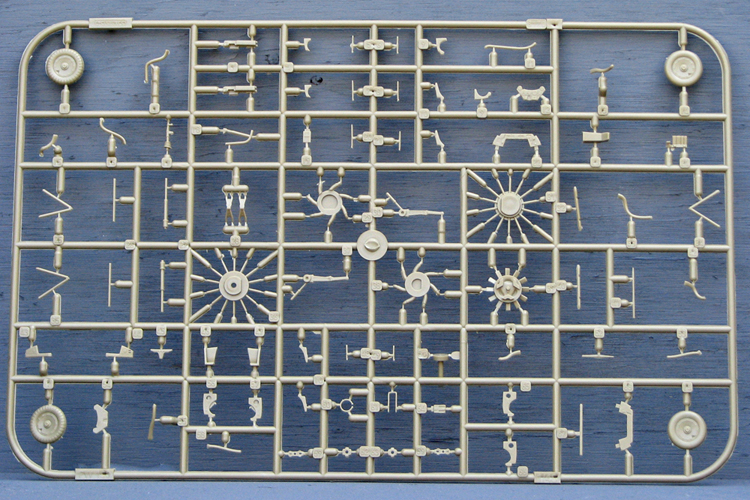 The cockpit is loaded with molded detail and includes multiple pre-painted photo-etch parts for seat belts as well as the option for PE parts for the main and side instrument panels. There is ample raised detail on the plastic parts for the instrument panels, so you will have an option as to whether to sand it off and use the Zoom set of PE parts, or to rely on painting and dry brushing the instrument panel parts alone. It comes down to a choice between the precision painting on the Zoom set, and the raised detail on the plastic parts providing a more three-dimensional look.
The cockpit is loaded with molded detail and includes multiple pre-painted photo-etch parts for seat belts as well as the option for PE parts for the main and side instrument panels. There is ample raised detail on the plastic parts for the instrument panels, so you will have an option as to whether to sand it off and use the Zoom set of PE parts, or to rely on painting and dry brushing the instrument panel parts alone. It comes down to a choice between the precision painting on the Zoom set, and the raised detail on the plastic parts providing a more three-dimensional look.
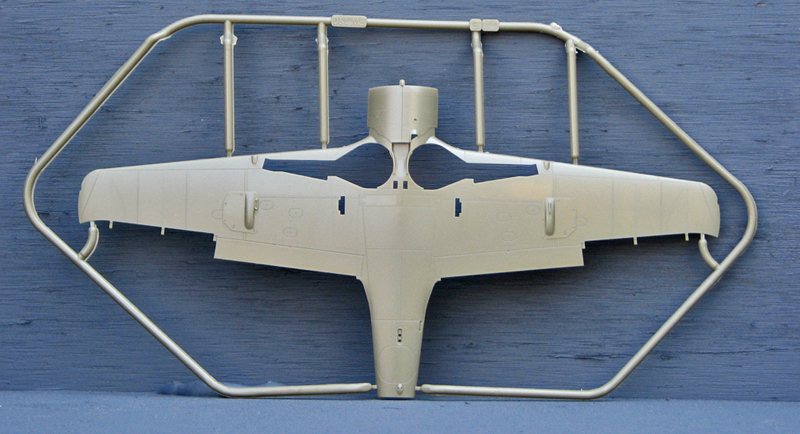 The kit is painstakingly engineered to reflect the detail of the actual Fw190. There is a detailed gun bay just forward of the cockpit, containing the two MG 131 13mm machine guns. In addition, the lower wing assembly contains a wing spar, against which the parts for the wheel wells and 20mm cannon positioned in the wing root are cemented. This spar will be visible through the open wheel wells of the completed kit, just as on the actual 190. The upper wings include parts for the cannon bays, which can be displayed in the open or closed position, and the ailerons are separately mounted. The double radial engine is highly detailed, consisting of 29 parts, including the hoses and engine mounts, and is surrounded by a 5-piece cowling.
The kit is painstakingly engineered to reflect the detail of the actual Fw190. There is a detailed gun bay just forward of the cockpit, containing the two MG 131 13mm machine guns. In addition, the lower wing assembly contains a wing spar, against which the parts for the wheel wells and 20mm cannon positioned in the wing root are cemented. This spar will be visible through the open wheel wells of the completed kit, just as on the actual 190. The upper wings include parts for the cannon bays, which can be displayed in the open or closed position, and the ailerons are separately mounted. The double radial engine is highly detailed, consisting of 29 parts, including the hoses and engine mounts, and is surrounded by a 5-piece cowling.
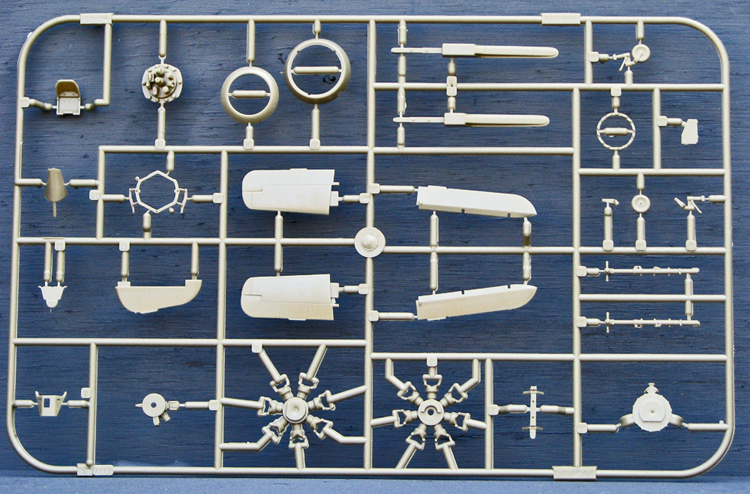 The landing gear have good detail on both the wheels and the separately mounted support struts, and there is an option for a detailed belly tank or a bomb, together with tubes for underwing rockets, which include rocket projectiles with photo-etch detail. The gun bays in the fuselage and wings can be assembled open or closed, and there are additional PE parts for the 190's trademark engine exhausts along the fuselage sides.
The landing gear have good detail on both the wheels and the separately mounted support struts, and there is an option for a detailed belly tank or a bomb, together with tubes for underwing rockets, which include rocket projectiles with photo-etch detail. The gun bays in the fuselage and wings can be assembled open or closed, and there are additional PE parts for the 190's trademark engine exhausts along the fuselage sides.
Decals
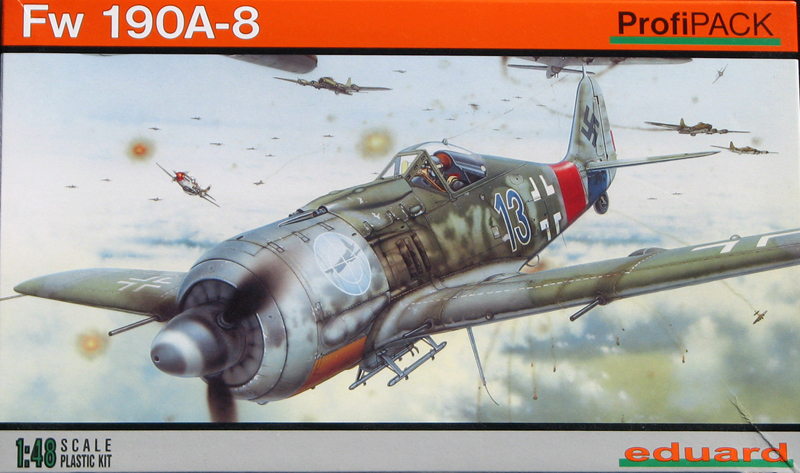 There are decals for four different versions, each of which has its own full page color plate showing a four-view profile.
There are decals for four different versions, each of which has its own full page color plate showing a four-view profile.
1) "Blue 13" -- the mount of Major Walter Dahl, Kommodore of JG 300, based at Juterborg, Germany in December 1944. The scheme of this aircraft included RLM74, 75, and 76 with mottled sides and featured a red band on the rear fuselage and a red silhouette of a B-17 in the crosshairs on its nose, as it was employed in Defence of the Reich operations against American daylight bombing raids. Blue 13 also had a black-and-white swirl pattern painted on its spinner;
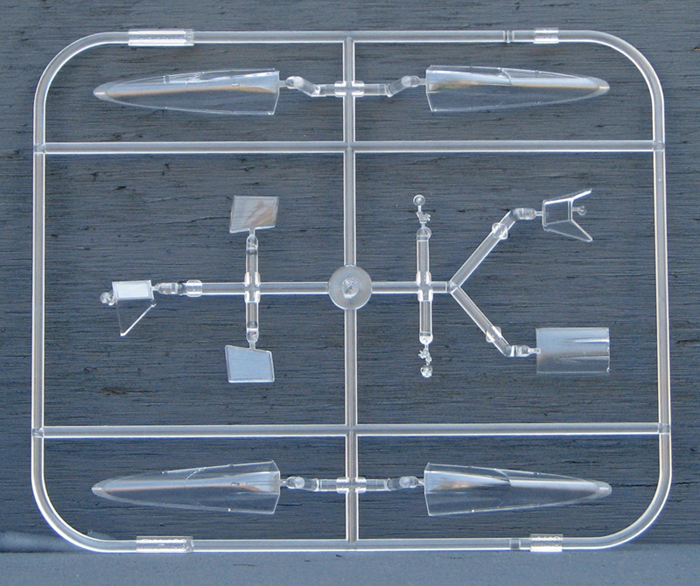 2) "White 2" -- flown by Unteroffizier Julius Handel with JG 54 on the collapsing Eastern Front in the period of August/September 1944. It bore a paint scheme of RLM 74, 75 and 76 with a yellow spinner and the unusual variation of the innermost section of the propeller blades also being painted yellow, along with yellow wingtips. White 2 included an American Indian head on the port side of the fuselage, just below the canopy. JG 54 stood down for R&R in September 1944, but resumed combat operations in the West when Uffz. Handel lost his life in a dogfight with USAAF P-47 Thunderbolts over Kieve/Nimwegen area in Holland on September 23, 1944, during Operation Market-Garden, the Allied invasion of Holland. Julius Handel was awarded the Iron Cross Second Class on September 25th;
2) "White 2" -- flown by Unteroffizier Julius Handel with JG 54 on the collapsing Eastern Front in the period of August/September 1944. It bore a paint scheme of RLM 74, 75 and 76 with a yellow spinner and the unusual variation of the innermost section of the propeller blades also being painted yellow, along with yellow wingtips. White 2 included an American Indian head on the port side of the fuselage, just below the canopy. JG 54 stood down for R&R in September 1944, but resumed combat operations in the West when Uffz. Handel lost his life in a dogfight with USAAF P-47 Thunderbolts over Kieve/Nimwegen area in Holland on September 23, 1944, during Operation Market-Garden, the Allied invasion of Holland. Julius Handel was awarded the Iron Cross Second Class on September 25th;
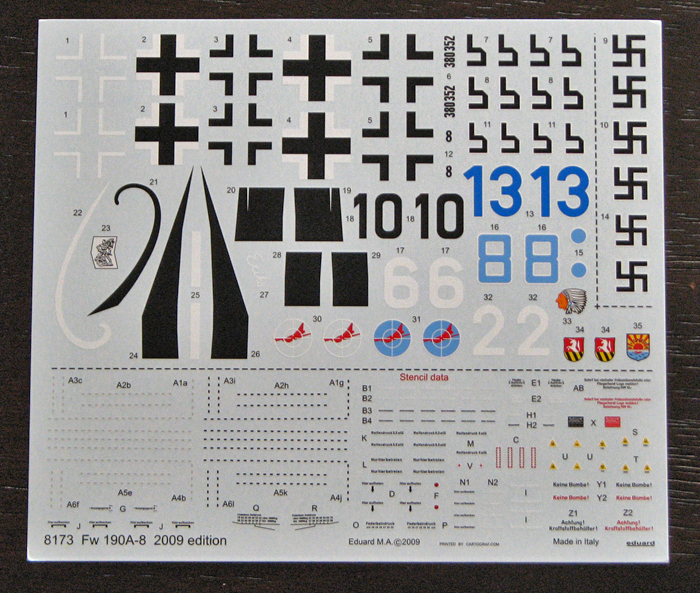 3) "Blue 8 -- Erika" -- one of several Fw190A-8 that JG 5 abandoned at Herdla, Norway after disbanding in the Spring of 1945. "Erika" carried a paint scheme of RLM 74, 75 and 76 with a blue cowl ring and a black-and-white swirl pattern on the spinner with a section of blue on the portion of the spinner nearest its base. Prior to disbanding, JG 5 took part in the defence of the northern sector of Occupied Europe;
3) "Blue 8 -- Erika" -- one of several Fw190A-8 that JG 5 abandoned at Herdla, Norway after disbanding in the Spring of 1945. "Erika" carried a paint scheme of RLM 74, 75 and 76 with a blue cowl ring and a black-and-white swirl pattern on the spinner with a section of blue on the portion of the spinner nearest its base. Prior to disbanding, JG 5 took part in the defence of the northern sector of Occupied Europe;
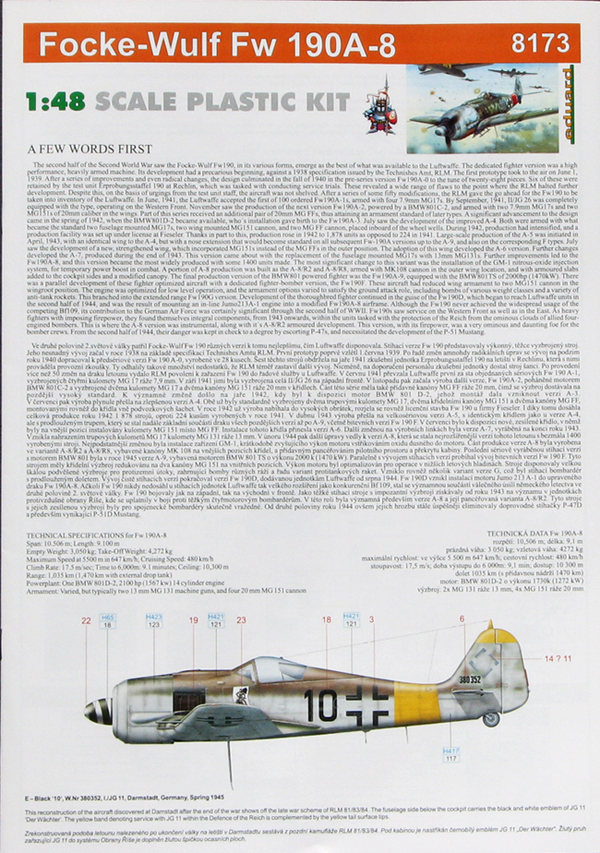 4) "White 6" - flown by Leutnant Gustav Salffner, commanding officer of 7.Staffel/JG 300, bearing the standard camouflage pattern for the closing months of the war. The top portion of the fuselage was sprayed RLM 83 (dark green), carried over to the side fuselage color RLM 76. The wings were covered with RLM 75/83. The scheme included blue-white-blue rear fuselage bands. The nose bore a coat of arms consisting of a unicorn on a red background over black and yellow diagonal stripes and was a simplified emblem of Salffner's family. Salffner ended the war with an Iron Cross Second Class and seven confirmed victories.
4) "White 6" - flown by Leutnant Gustav Salffner, commanding officer of 7.Staffel/JG 300, bearing the standard camouflage pattern for the closing months of the war. The top portion of the fuselage was sprayed RLM 83 (dark green), carried over to the side fuselage color RLM 76. The wings were covered with RLM 75/83. The scheme included blue-white-blue rear fuselage bands. The nose bore a coat of arms consisting of a unicorn on a red background over black and yellow diagonal stripes and was a simplified emblem of Salffner's family. Salffner ended the war with an Iron Cross Second Class and seven confirmed victories.
Conclusion
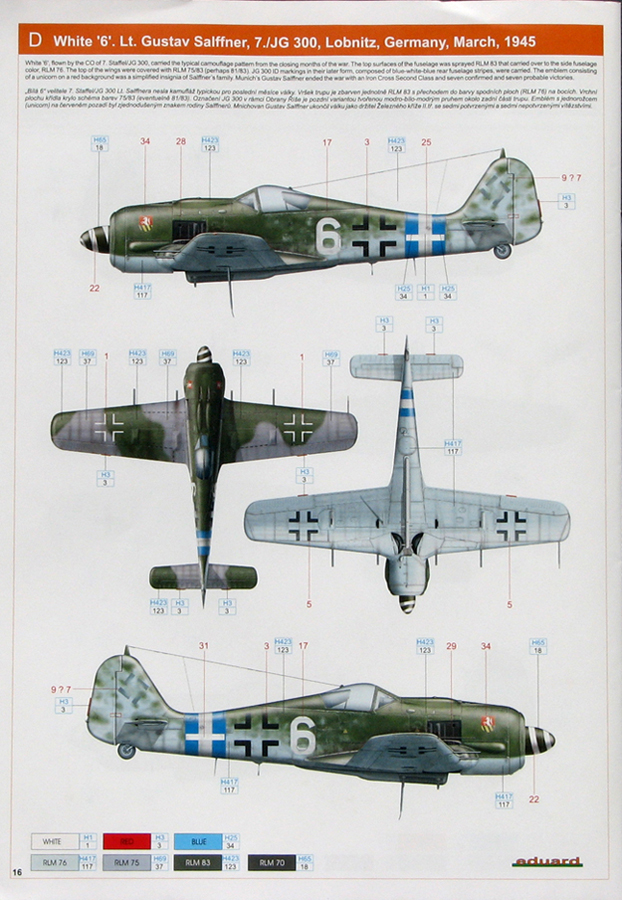 Eduard's Focke Wulf Fw190A-8 is a great kit, and shows every sign of being painstakingly recreated from actual schematics of the original Luftwaffe fighter. No detail has been omitted, from the cockpit to the BMW 801 engine to the wheel wells - the kit's single drawback may be that there is no clearly described method to realistically display its highly detailed engine, save for removing a cowling panel. Highly recommended.
Eduard's Focke Wulf Fw190A-8 is a great kit, and shows every sign of being painstakingly recreated from actual schematics of the original Luftwaffe fighter. No detail has been omitted, from the cockpit to the BMW 801 engine to the wheel wells - the kit's single drawback may be that there is no clearly described method to realistically display its highly detailed engine, save for removing a cowling panel. Highly recommended.
Thanks to Eduard for the review kit.